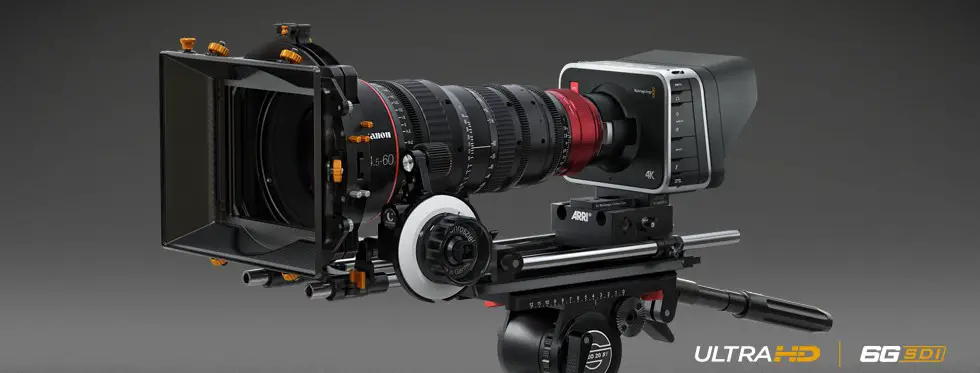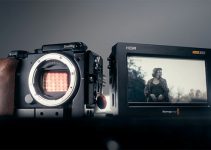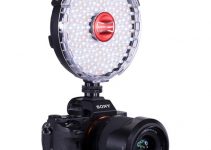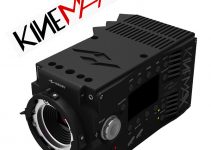The Blackmagic Production Camera (BMPC) was the first camera from Blackmagic Design to shoot 4K. It was one of the hottest cameras announced at NAB 2013 and upon its release it was limited to recording in ProRes 422 HQ only in 4K mode.
However, this changed in June this year, after the highly anticipated firmware update 1.8, which enabled 4K raw shooting on the BMPC.
And despite currently living somewhat in the shadow of the new 4K URSA, the BMPC is still a fantastic tool in the arsenal of the 4K shooter. The camera shares the body of its 2.5K BMCC predecessor, however ups the specs with a 4K Super 35mm sensor and a global shutter. Two huge improvements over the oddly sized sensor in the original Blackmagic Cinema Camera which topped out at 2.5K resolution in raw mode.
Dynamic range took a hit – about a stop below the 13 stops DR of the original BMCC. However even at 12 stops dynamic range, the 4K raw out of the Blackmagic Production Camera is stunning when used properly and in capable hands. Some folks out there were not particularly impressed with the dynamic range in some of the first samples of footage to come out of the camera shortly after its release, while others were quick to dismiss it altogether following this year’s NAB announcement of the 4K URSA in all its versions. Comments about a “less cinematic, and more video-ish” look out the BMPC quickly surfaced.
I tend to disagree on that front. It really depends on how you shoot with the BMPC, exposure, lens choice and diffusion. Much like with any other camera, but here we’re dealing with a 12 stop 4K sensor with a global shutter, the presence of which may required a sacrifice of a stop or so of dynamic range, but this camera is a very capable tool and certainly very capable of producing lovely cinematic images in 4K.
Below are some recent examples of some gorgeous cinematic 4K raw footage:
Mys 2 – BMPC4K raw from Ola Harström on Vimeo.
Here are some specs from the above clip:
Everything is shot raw at ISO 400. Lenses are Canon 24mm 1.4, Sigma 50mm 1.4 and Samyang 85mm 1.4;
Edited and graded in DaVinci Resolve.
Female Leader Engineer from Ola Harström on Vimeo.
BMPC 4K raw – lenses used – Sigma 50mm 1.4 and Samyang 85mm 1.4
After it was released, the BMPC was often criticised for its “not-so-low light” optimised sensor with a native ISO of 400 and a slew of low light comparisons videos against the BMCC and the Pocket Cinema Camera flooded the Internet. Of course, the sensor is not the most light sensitive sensor ever made, but as with any other camera, with the proper tools, knowledge, and hard work one should be able to get relatively good if not even great low light results.
Here’s an incredible low light piece by Brad Bell shot in 4K raw on the BMPC:
Blackmagic 4k | In the Mist from bradbell.tv on Vimeo.
Here’s more details on the footage from Brad:
Shot on the Blackmagic Production Camera in 4k. Download in 4k. Shot at 400 ASA with a Canon 28mm f2.8 lens at f5.6, at 7:30am on 31 March 2014. Graded with an Ilford Delta 400 film LUT from FilmConvert.
The black and white grade is very strange for me as I’d normally be the person arguing on aesthetic grounds for colour. I’ve literally never created a black and white image before. However, the fog had already taken most of the colour out of the images, and with the increased resolution, it felt like it needed a more reductive approach.
The Production Camera is also a more contrasty camera than I’m used to, although the Ilford D400 was the least contrasty of black and white LUTs, as I recall. There is zero grain because it would detract from the fog and get slammed in compression. I normally shoot with a 2.4:1 crop, which is etched in marker on my cameras, as it’s more compositionally elegant and mathematically pure.
View in 1080p. Registered Vimeo users can download the original file in 4k, as Vimeo doesn’t display 4k yet. I think I got away with a pretty low data rate for the H.264 file at a mere 40Mbps.

I am quite fond of the 4K Blackmagic Production Camera. Despite its quirks, the sensor does a good job at minimising aliasing and moire in 4K, and the down-sampled 1080p from 4K is fantastic.
The global shutter and the cinema standard Super 35mm sensor alone are extremely valuable features to have on this camera. The global shutter is invaluable here as it eliminates the dreaded “jello effect”, which was quite painful at times to deal with when shooting hand-held or panning the camera quickly to follow a movement.
I tend to shoot a lot of my stuff in a “run-n-gun” type of “docu” style, so these ability to have a manageable crop (about 1.6x full-frame equivalent) on my lenses and no more having to worry about rolling shutter issues is a massive plus. In addition having the ability to shoot in 12-bit 4K raw and 4K ProRes in a familiar to me form factor as a previous BMCC owner is quite significant.
Disclaimer: As an Amazon Associate partner and participant in B&H and Adorama Affiliate programmes, we earn a small comission from each purchase made through the affiliate links listed above at no additional cost to you.




